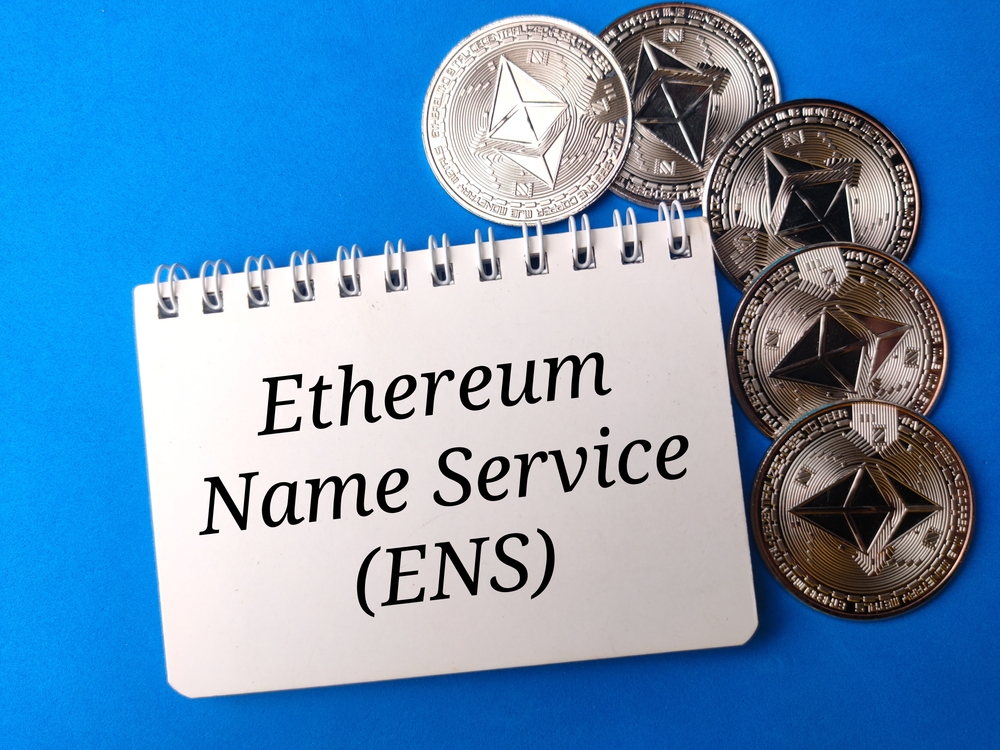The Ethereum Name Service (ENS) stands as a transformative aspect of the Ethereum blockchain, enhancing user experiences by simplifying interactions with blockchain addresses.
It operates as a key interface between complex alphanumeric blockchain addresses and more familiar, easy-to-remember names. Essentially, ENS offers a user-friendly naming system for Ethereum addresses and other machine-readable identifiers.
For example, an Ethereum address can be converted into a straightforward name like “alice.eth”. This not only makes it easier for users to engage with Ethereum addresses but also reduces the risk of errors commonly associated with traditional lengthy addresses.
ENS’s integration into the Ethereum blockchain ensures a decentralized and secure system, offering a level of customization and control for domain owners. It is a vital tool in making Ethereum more accessible and user-friendly, fostering broader adoption and use of blockchain technology.
How ENS Works
ENS functions through a well-structured system comprising two primary components: the Registry and the Resolvers. These elements work in tandem to provide a seamless, efficient service.
1. Registry: The Registry acts as the backbone of ENS. It is essentially a smart contract on the Ethereum blockchain that maintains a comprehensive list of all domains and subdomains. This contract records crucial details for each entry, such as domain ownership, resolver assignment, and Time-to-Live (TTL) for record caching.
2. Resolvers: Resolvers are crucial in translating human-readable names into Ethereum addresses. Any contract adhering to ENS standards can function as a resolver.
The resolution process involves two steps: querying the Registry to identify which resolver is associated with a particular name and then asking that resolver to convert the name into an address.
Acquiring an ENS Domain
Obtaining your own ENS domain involves a streamlined three-step process: getting a crypto wallet, purchasing ETH, and selecting an ENS domain.
1. Acquiring a Crypto Wallet
Importance of a Wallet: A crypto wallet like MetaMask is essential for two main reasons. Firstly, it’s where you’ll store ETH, necessary for paying for your ENS domain. Secondly, the wallet’s address serves as the point your ENS domain will direct to.
Choosing a Wallet: There are various wallet options compatible with ENS, each with its unique features. Your choice should be based on factors like user-friendliness, security features, and compatibility with ENS.
2. Purchasing ETH
Acquiring ETH: ETH can be acquired through various platforms, including centralized exchanges like Coinbase or decentralized exchanges (DEXs).
Budget Considerations: The amount of ETH needed is influenced by factors like the length of the desired domain and the current Ethereum gas fees. These fees are subject to fluctuation and can significantly impact the overall cost of acquiring an ENS domain.
3. Choosing an ENS Domain
ENS Dapp Navigation: To start the domain selection process, visit the ENS decentralized application (dapp).
Connecting Your Wallet: Connect your chosen wallet to the ENS dapp, a necessary step for integrating your wallet with the ENS service.
Domain Selection and Registration: Search for the domain you desire, check its availability, and follow the registration process as outlined by the dapp. Remember to consider the gas fees as part of the total cost.
The Uniqueness of ENS Compared to DNS
ENS, while sharing a conceptual similarity with the Domain Name Service (DNS), is uniquely adapted for the Ethereum blockchain. While DNS maps human-readable domain names to IP addresses, ENS focuses on linking easy-to-remember domain names to Ethereum addresses, thereby making cryptocurrency addresses more accessible and user-friendly.
Registering an ENS Domain
Registering an ENS domain typically requires a wallet like MetaMask. The official ENS domain registration site offers a straightforward process to search for and register your desired domain.
Governance of ENS
The governance of ENS is multifaceted, with the ENS token playing a central role. This ERC-20 token is used for governance actions like proposal submissions and voting. Token holders are engaged in discussions and governance matters on the ENS forum. The initial distribution of the ENS token was through an airdrop to early adopters, with specific guidelines for distribution.
Conclusion
The Ethereum Name Service significantly lowers the barrier for everyday users to interact with the Ethereum blockchain by transforming complex addresses into simple, memorable names.
The process of acquiring an ENS domain, while technical, is made user-friendly through a structured approach, involving careful planning, especially in terms of budgeting for fluctuating gas fees.
This guide not only equips you with the knowledge to acquire your own ENS domain but also highlights the broader significance of ENS in the adoption and use of blockchain technology, paving the way for a more accessible and efficient digital asset ecosystem.
